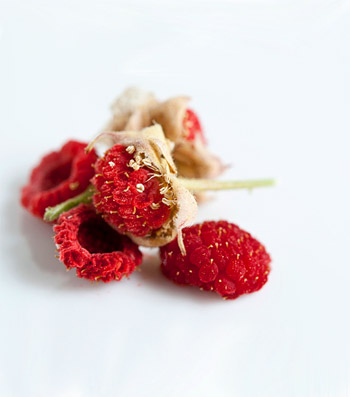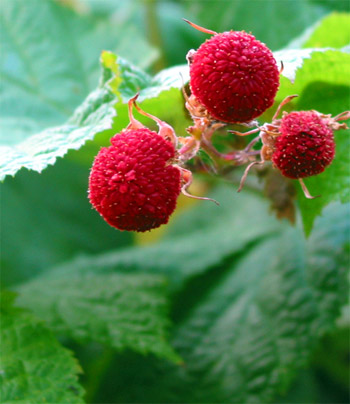|
|
|
 , ,
Font size |
Encyclopedia of Health Benefits of Berries

29. Thimbleberries:
The thimble-like shape of these fruits give them their name. These have
a beautiful red color when they become ripe. These are fleshy fruits that are so
delicate that they may break in your hand when picked from the plant.
Thimbleberries, also known as salmon berries or mountain sorrel, resemble
raspberries in appearance, although they have far more seeds. The taste is also
not as sweet as raspberries, although many people enjoy the taste of
thimbleberries. This small, red berry is not commonly found in grocery stores,
although you may find it in specialty markets or forage for it yourself in the
wild. Thimbleberries offer a range of nutritional value. Thimbleberry is a
perennial flowering plant from the Rubus genus in the Rosaceae or rose family.
These plants are native to various regions of North America. The fruits or
berries of these shrubs are edible and are sweet in taste. These fruits are also
known as salmonberry.
Young shoots of these plants are also edible. Thimbleberry plants are used for
numerous medicinal purposes as well.
Calories and Macronutrients
A 100-g serving of thimbleberries contains 47 calories. If you eat a
2,000-calorie meal plan, this accounts for very little of the allowed calories
per day -- 2.4 percent. These berries are also quite low in fat. One serving has
0.33 g, an amount that barely contributes to the recommended limit of 20 to 35
percent of your daily calories. You will get very little protein in a serving of
thimbleberries: less than 1 g. A 100-g portion does contain 10 g of
carbohydrates, however, and this contributes to the 130 g per day suggested for
daily intake by the Institute of Medicine.
Vitamins
Include thimbleberries in your diet, and you will get a boost in your vitamin C
consumption; a serving has 15 percent of the amount you need each day. The
vitamin C in this berry improves the state of your immune system, helping to
ward off infections. It speeds wound healing, as well, making thimbleberries a
good choice when you are injured. You will also get 10 percent of the daily
recommended intake of vitamin A. This vitamin has many benefits for your vision,
including night vision and protection against infections that can attack the
surface of your eyes.
Minerals
Thimbleberries offer small amounts of a variety of minerals. One serving
provides 3 percent of the suggested daily consumption level of potassium, an
electrolyte that helps keep your blood pressure at an even keel. You'll also get
2 percent of the daily recommended intake of iron, as well as 1 percent of the
calcium you need each day. Eating thimbleberries won't meet your mineral needs
for any of these nutrients, so supplement your diet with other foods rich in
potassium, iron and calcium to ensure your optimal health.
Benefits
 While you can eat thimbleberries fresh, made into jam or incorporated into
larger recipes, proponents of this berry note that it may find use as a folk
medicine for lessening the symptoms of intestinal problems, including nausea and
an unsettled stomach. The Raw Family August/September 2007 newsletter recommends
drying the roots of the thimbleberry plant to make into tea; this beverage
allegedly helps clear up diarrhea. No scientific data exists to confirm this
usage, however, so exercise caution. Consult your physician before using
thimbleberry for a medicinal purpose. While you can eat thimbleberries fresh, made into jam or incorporated into
larger recipes, proponents of this berry note that it may find use as a folk
medicine for lessening the symptoms of intestinal problems, including nausea and
an unsettled stomach. The Raw Family August/September 2007 newsletter recommends
drying the roots of the thimbleberry plant to make into tea; this beverage
allegedly helps clear up diarrhea. No scientific data exists to confirm this
usage, however, so exercise caution. Consult your physician before using
thimbleberry for a medicinal purpose.
Thimbleberry Nutritional Fact
The delicious berries of this plant are fairly nutritious as they contain
moderate amounts of vitamins and minerals that help in the growth and immunity
of human body. Per 100 gm berries contain:
-
Carbohydrates: 10 gm
-
Fat: 0.33 gm
-
Protein: 1 gm
-
Calories: 47
They contain the vitamins A and C in minor amount. Small amount of various
minerals including potassium, iron and calcium are also present in these fruits.
Next..
Dated 12 March 2013

|
|
|
|
|
|
|









